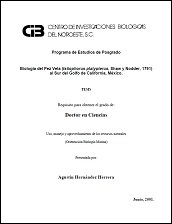The contents of Cd, Cu, Pb and Zn of the white shrimp Litopenaeus vannamei (Boone, 1931) of six coastal lagoons of Sinaloa, NW Mexico
Contenido de Cd, Cu, Pb y Zn en el camarón blanco Litopenaeus vannamei (Boone, 1931) de seis lagunas costeras de Sinaloa, NW de México
Autor
MARTIN GABRIEL FRIAS ESPERICUETA
JOSE ISIDRO OSUNA LOPEZ
DOMENICO VOLTOLINA LOBINA
MARCO ANTONIO BELTRAN VELARDE
GABRIEL LOPEZ LOPEZ
MARIA DOLORES MUY RANGEL
WERNER RUBIO CARRASCO
Metadatos
Mostrar el registro completo del ítemResumen
"El camarón Litopenaeus vannamei es la especial más importante en la pesquería tradicional de las lagunas costeras del estado de Sinaloa (NW de México), y la mayoría de sus capturas son consumidas localmente. Estas lagunas reciben grandes volúmenes de efluentes agrícolas, industriales y urbanos, por lo cual el consumo del camarón podría representar un riesgo para la salud humana. El contenido medio de Cd, Cu, Pb y Zn en el hepatopáncreas de las capturas comerciales en seis lagunas de Sinaloa fue mayor que su respectivo valor en el músculo; no se observó una correlación entre el contenido de Cd, Cu y Pb de los dos tejidos (P>0,1); en el caso de Zn la correlación resultó significativa con un bajo nivel de probabilidad (P≤0,05). La concentración en el músculo del camarón fue similar o menor que la determinada en capturas comerciales de otros crustáceos en otras regiones. Con base en estos resultados, el consumo de los camarones locales no constituye un riesgo para la salud humana." "Litopenaeus vannamei is the most important shrimp species in the traditional fishery of the coastal lagoons of the State of Sinaloa (NW Mexico), and most of the landings are consumed locally. Since these lagoons receive important volumes of agricultural, industrial and urban effluents, consumption of this shrimp could pose risks to human health. The mean content of Cd, Cu, Pb and Zn determined in the hepatopancreas of shrimp from commercial landings from six lagoons of Sinaloa were higher than those of the muscle. There was a weak correlation between the Zn content of the two tissues (P≤0.05) and the correlations were not significant for Cd, Cu and Pb (P>0.1). The concentrations found in the shrimp muscle were comparable or lower than those determined in commercial landings of different crustaceans from other geographic areas. According to our results the consumption of local shrimp poses no risks to human health."
Colecciones
Ítems relacionados
Mostrando ítems relacionados por Título, autor o materia.
-
PROMOCIÓN DEL PERIFITON PARA EL CULTIVO DE CAMARÓN BLANCO: HACIA UNA ACUICULTURA ECOLÓGICA
DOMENICO VOLTOLINA LOBINA; JUAN MANUEL AUDELO NARANJO; MARIA DEL ROSARIO PACHECO MARGES -
Suelo y Erosión
YOLANDA LOURDES MAYA DELGADO


